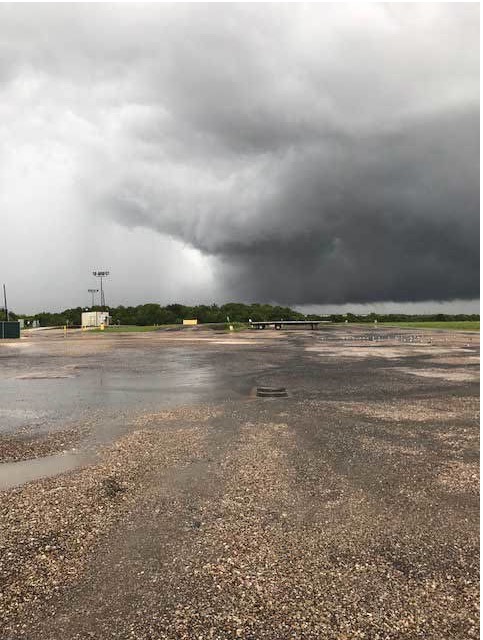December 2017, Vol. 244, No. 12
Features
How Harvey Heroics Helped to Save JSW Steel

If necessity truly is the mother of invention, there are not too many greater motivators of creative thinking than the destructive force of a hurricane, as employees at JSW Steel (USA) discovered in late August.
With Hurricane Harvey barreling down on the 700-acre facility, a handful of the company’s workers made a bold decision – they would stay on the property until the storm subsided in an effort to protect the plant’s millions of dollars worth of equipment from floodwater.
“I explained to my volunteers that, in all likelihood, they would be stuck and not able to leave,” Gary Baggett, director of facilities, told P&GJ. “Where we are located is surrounded by what I’d describe as a barrier of bayous.”
JSW Steel, situated about 30 miles east of Houston in Baytown, is indeed in bayou country. The city itself is a mere 34 feet above sea level and subject to coastal storms and flooding in the best of times, which these were not.
A meeting was held at the plant on Aug. 24 to decide if the facility would remain in operation during Harvey if the storm reached shore in the area. CEO John Hritz said there were “a lot of debates and arguments” but by the next morning it became clear that “we needed to get our people home.”
A core group of about a dozen of the company’s employees volunteered to stay on, including Baggett. A shutdown of machines, electrical systems and computer hardware was implemented in time for nearly 400 employees to head home to their families.
Harvey made landfall on the Texas Gulf Coast on Aug. 25, with winds topping 130 mph. As floodwaters reached the property, rain stood ankle-deep and the basement began to flood. The chief worry at this point concerned the steel mill. While it had huge pieces of machinery aboveground, it also contained massive motors and other vulnerable high-voltage equipment underground. As the rain continued to pour, Baggett sent a video of the situation to Hritz, who was out-of-state recovering from surgery.
“Obviously, the equipment in the basement was the big concern,” Hritz told P&GJ. “There was no way we could stop this.”
That was when an idea took root. It was decided that a dam would be built using a monster front-end loader in an attempt to restrain the water. And, the dam would be built from the tiny slivers of steel, left behind from tooling, which the mill had in abundance.
“The water could not get through this at all,” Hritz said. “It was much better than sandbags, plus it would have required thousands of sandbags.”
Baggett said during a lull in the storm on the first day that he checked road conditions and was able drive into Baytown where a hardware store remained open. He was able to buy three blow-up mattresses for his crew to sleep on, but as it turned out, there was little time for napping.
“Because there were so few of us, we were kept busy swapping out pumps in the basement,” he said. “Some pumps could not keep up, so that kept us pretty busy.”
The crew had to work at a rapid pace and around the clock for the duration of the rain, which eventually stood waist-deep outside the plant. Nevertheless, in the end, none of what Baggett estimated to be “easily $100 million worth of equipment” was lost.
Additionally, and arguably of equal importance, JSW Steel did not lose any contracts due to shutdowns. That, in itself, is quite a testament considering the plant produces 500,000 tons of 24- to 48-inch pipe a year, along with 1.2 million tons of plate.
“We had to dry out a few things, of course,” Hritz said. “This was a monster storm and as far as I know we are not making any insurance claims. That’s a fabulous tribute to these men.”
That the mill, which is located at a site built over 40 years ago by U.S. Steel to produce pipe for the Trans-Alaska Pipeline, was undergoing tens of millions of dollars for modernization, included retrofitting, at the time of the storm made the situation even more dire.
Fortunately, the company’s substation is located high enough that the crew did not have to deal with power outages. Another lucky break, if it could be called that, was that neither of the two tornadoes that crossed over the facility touched down on the bayou. Additionally, no employees were injured scurrying around the property.
By Sept. 5, the company was shipping again; the following day, the plate mill and part of the pipe mill had resumed operation. Had the basements filled and the equipment been destroyed, however, the time needed to replace it would have been difficult to calculate. As Hritz put it, “America has lost the ability to build a lot of this type of equipment,” which means extensive long-distance shipping time would have been involved.
During the cleanup that followed Harvey, crews had to contend with more than moisture as rats, snakes and other unwanted visitors had invaded the mill in search of drier spots.
“There were lots of snakes from the bayous, so that was something else we had to watch out for,” Baggett said.
Added Hritz, “I’d just as soon never talk about anything even close to this again. This storm was a monster, and it’s pretty amazing how our team saved us from a protracted outage.”
The Houston-based division of the India-based company also established a fund to assist employees forced out of their homes by the storm.
“Spotlight on Utilities” highlights some of the innovations and achievements of those in the business of providing natural gas to homes and businesses. If you have a suggestion for inclusion in the column, email mreed@oildom.com.





Comments